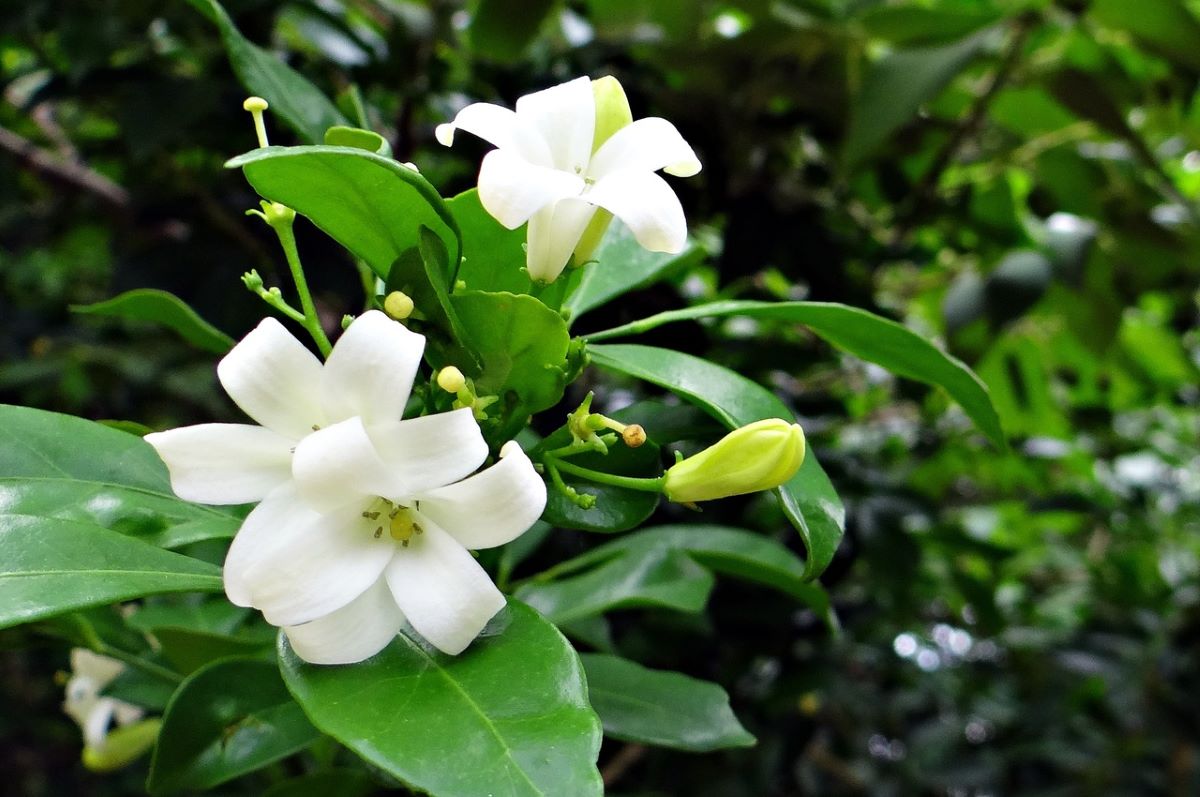
Gardenias are wonderful shrubs. They produce very decorative pure white flowers, and their leaves are a bright dark green color that make these plants one of the most loved in both gardens and patios.
However, sometimes they can be confused with other plants, so we are going to explain to you what are the characteristics of gardenias so that it is easier for you to recognize it when you see it.
What is gardenia like?
Gardenia is a shrub or small tree belonging to the Rubiaceae family. It grows naturally in Asia, where it is highly appreciated especially in China. Reaches a height of between 2 and 8 meters, although in cultivation it rarely exceeds one meter. Its leaves are of a glossy dark green color elliptical or obovate-elliptical, more or less leathery and with a very visible central nerve.
Its flowers are solitary and terminal, composed of beautiful and magnificent pure white petals. They are so elegant, that in China they have come to be considered as the symbol of subtlety, artistic merit and feminine beauty.
Varieties or types of gardenias
Although we only know one species in depth, the Gardenia jasminoides, In fact the genus is made up of a hundred species, which include:
Gardenia brighamii

Image - Flickr / David Eickhoff
La Gardenia brighamii is a small tree-shaped shrub endemic to Hawaii that reaches 5 meters in height. It has glossy dark green ovate leaves and white flowers about 2-3 centimeters in diameter.
Gardenia jasminoides

La Gardenia jasminoides it is the most common. It is known as Cape Jasmine or Indian Jasmine, and It is a shrub or tree that reaches a maximum of 8 meters in height. It is native to Asia, and develops obovate-elliptical or elliptical leaves, somewhat leathery, of a glossy dark green color. It blooms in spring, and it does so by producing white flowers about 5 centimeters in diameter.
Gardenia tahitensis

Image - Wikimedia / Forest & Kim Starr
La Gardenia tahitensis, known as Tahiti flower, is a shrub native to the islands of the South Pacific and Vanuatu. Measures 4 meters high, and produces white or sometimes yellow flowers that give off an aroma very similar to that of jasmine (Jasminum).
Gardenia thunbergia

Image - Wikimedia / michael clarke stuff
La Gardenia thunbergia It is a small tree native to South Africa that reaches 5-6 meters in height. It develops a rounded, very dense crown, from which simple, glossy dark green leaves sprout. Its flowers are white, up to 7 centimeters in diameter, and very aromatic.
What are the gardenia care?
With this plant you can have a perfectly decorated garden, patio or terrace, since supports pruning well and does not require much maintenance to look good. You only need protection against the sun king, an acidic soil and irrigation water, and to be in a place where it cannot be affected by intense frosts.
But we are going to see in detail all the care that must be given to this plant:
Where to put a gardenia?
The gardenia needs a lot of light to be able to have a good development, therefore it is very important that it is placed in a bright placeregardless of whether it will be outdoors or indoors.
In the event that it is going to be planted in the ground, we will not have to worry about its root system, since its roots are not invasive.
Earth

Image - Wikimedia / Forest & Kim Starr
The land on which I grow it must have a low pH between 4 and 6, that is, it must be acidic. And it is that in alkaline soils the leaves will present iron chlorosis, as a consequence of the lack of iron. To know what pH your soil has, you can use a pH meter for example.
If you are going to grow it in a pot, you simply have to plant it in one with acidic substrates, such as coconut fiber (for sale here), or with one prepared for acidic plants (such as this).
How do you water a gardenia?
The irrigation water must be of clean rain. If you can't get it, the tap will do as long as it's fit for human consumption. Water about three times a week, less in winter you will have to do it less since the earth takes longer to dry out.
In addition, you must add water until all the soil or substrate is wet, since otherwise all the roots would not be hydrated and problems could arise.
Subscriber
On the other hand, it is highly recommended to fertilize it with fertilizers for acid plants (as this), following the manufacturer's instructions for use, from early spring to late summer.
Transplant
If it is in a pot we have to change it to a larger one approximately every 3 or 4 years in spring. The plant grows slowly, so it will not need us to transplant it in a row.
In the event that we are going to plant it in the garden, we must wait for the winter to end.
Rusticity
Generally gardenias are frost sensitive plants. The one that best withstands the cold is the most common, the Gardenia jasminoides, but even so, you should not leave it outside if the temperatures drop below -2ºC. There is a cultivar, 'Kleim's Hardy', that supports a little more, down to -9ºC, according to the website of the Missouri Botanical Garden (United States).

Did you find this article helpful?
I found the article very useful. I have two Jasmines after many years of trying and everything matches what is explained here.
Hello Luisa.
We are glad to have been of help. Any questions you have, do not hesitate to write us 🙂
regards